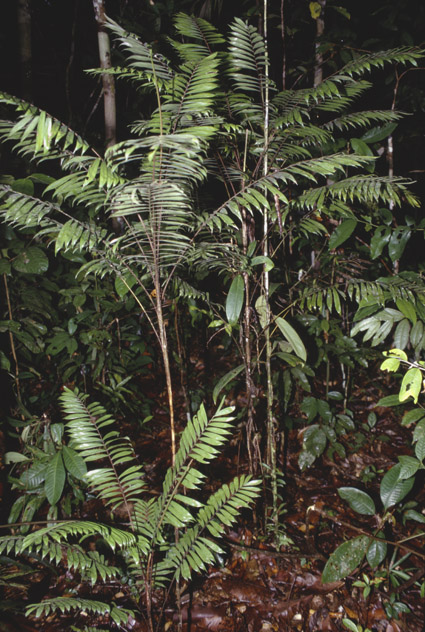- Acanthophoenix
- Acrocomia
- Actinokentia
- Actinorhytis
- Adonidia
- Aiphanes
- Allagoptera
- Ammandra
- Aphandra
- Archontophoenix
- Areca
- Arenga
- Asterogyne
- Astrocaryum
- Attalea
- Balaka
- Barcella
- Basselinia
- Beccariophoenix
- Bismarckia
- Borassodendron
- Borassus
- Brassiophoenix
- Burretiokentia
- Butia
- Calamus
- Calyptrocalyx
- Calyptrogyne
- Calyptronoma
- Carpentaria
- Carpoxylon
- Caryota
- Ceratolobus
- Ceroxylon
- Chamaedorea
- Chamaerops
- Chambeyronia
- Chelyocarpus
- Chuniophoenix
- Clinosperma
- Coccothrinax
- Cocos
- Corypha
- Cryosophila
- Cyphokentia
- Cyphophoenix
- Cyphosperma
- Daemonorops
- Deckenia
- Desmoncus
- Dictyocaryum
- Drymophloeus
- Dypsis
- Elaeis
- Eleiodoxa
- Eremospatha
- Eugeissona
- Euterpe
- Gaussia
- Geonoma
- Guihaia
- Hedyscepe
- Hemithrinax
- Howea
- Hyophorbe
- Hyospathe
- Hyphaene
- Iriartea
- Iriartella
- Itaya
- Jailoloa
- Johannesteijsmannia
- Juania
- Jubaea
- Jubaeopsis
- Kentiopsis
- Kerriodoxa
- Korthalsia
- Laccospadix
- Laccosperma
- Lanonia
- Latania
- Lemurophoenix
- Leopoldinia
- Lepidocaryum
- Lepidorrhachis
- Leucothrinax
- Licuala
- Linospadix
- Livistona
- Lodoicea
- Lytocaryum
- Manicaria
- Manjekia
- Marojejya
- Masoala
- Mauritia
- Mauritiella
- Maxburretia
- Medemia
- Metroxylon
- Myrialepis
- Nannorrhops
- Nenga
- Neonicholsonia
- Neoveitchia
- Nephrosperma
- Normanbya
- Nypa
- Oenocarpus
- Oncocalamus
- Oncosperma
- Orania
- Oraniopsis
- Parajubaea
- Pelagodoxa
- Phoenicophorium
- Phoenix
- Pholidocarpus
- Pholidostachys
- Physokentia
- Phytelephas
- Pigafetta
- Pinanga
- Plectocomia
- Plectocomiopsis
- Podococcus
- Pogonotium
- Ponapea
- Prestoea
- Pseudophoenix
- Ptychococcus
- Ptychosperma
- Raphia
- Ravenea
- Reinhardtia
- Retispatha
- Rhapidophyllum
- Rhapis
- Rhopalostylis
- Roscheria
- Roystonea
- Sabal
- Sabinaria
- Salacca
- Saribus
- Satakentia
- Satranala
- Schippia
- Sclerosperma
- Socratea
- Solfia
- Sommieria
- Syagrus
- Synechanthus
- Tahina
- Tectiphiala
- Thrinax
- Trachycarpus
- Trithrinax
- Veitchia
- Verschaffeltia
- Voanioala
- Wallaceodoxa
- Wallichia
- Welfia
- Wendlandiella
- Wettinia
- Wodyetia
- Zombia
- x Jubautia splendens
- ?? Acoelorrhaphe
- ?? Bentinckia
- ?? Brahea
- ?? Clinostigma
- ?? Colpothrinax
- ?? Copernicia
- ?? Cyrtostachys
- ?? Dictyosperma
- ?? Dransfieldia
- ?? Heterospathe
- ?? Hydriastele
- ?? Iguanura
- ?? Incertae sedis & excluded names
- ?? Loxococcus
- ?? Micronoma
- ?? Paripon
- ?? Pritchardia
- ?? Rhopaloblaste
- ?? Serenoa
- ?? Washingtonia

Distribution
Map uses TDWG level 3 distributions (https://github.com/tdwg/wgsrpd)
Amazon region of Colombia (Amazonas), the Guianas, Brazil (Amazonas, Pará, Rondonia), and Bolivia (Pando). (Henderson, A.J., Bactris (Palmae) in Flora Neotropica Monographs 79. 2000)A
Habitat
- Lowland rain forest on terrafirme, at 100-275 m elevation. (Henderson, A.J., Bactris (Palmae) in Flora Neotropica Monographs 79. 2000)A
Discussion
- Bactris elegans is diagnosed by its small, regularly arranged (but with gaps), asymmetrically and briefly bifid, glossy green pinnae, inflorescence with (1-)2 rachillae, and purple-black, globose fruits. (Henderson, A.J., Bactris (Palmae) in Flora Neotropica Monographs 79. 2000)A
Common Name
- Brazil: marajá. Colombia: eérü (Huitoto). French Guiana: wili (Wayâpi). Guyana: firichí. Suriname: akamin-ékoenari, moeroekoe. (Henderson, A.J., Bactris (Palmae) in Flora Neotropica Monographs 79. 2000)A
Description
- Stems cespitose, forming loose to dense clumps of to 8 stems, 1.5-3.5 m tall, 0.8-1.5 cm diam., spiny or not spiny on internodes.
Leaves 6-13; leaf spines scattered, terete, black or dark brown, rarely yellowish, to 4 cm long, on sheath and proximal part of petiole, usually absent from rachis; sheath 9-30 cm long; ocrea to 4 cm long; petiole 11-40 cm long; rachis 47-75 cm long, densely covered with soft, fine, brown spinules to 1 mm long; pinnae 17-32 per side, regularly arranged except for gaps, spreading in the same plane, linear-Ianceolate to almost sigmoid, asymmetrically and briefly bifid and pendulous apically, glossy green adaxially, with small spines on margins; middle pinnae 9-22 x 1-2.5 cm.
Inflorescences interfoliar; peduncle 18-25 cm long, recurved, spiny; prophyll 10-15 cm long; peduncular bract 30-42 cm long, densely brown-tomentose with few to many black spines to 1.5 cm long; rachis absent; rachillae (1-)2, 8-15 cm long, at anthesis densely covered with reddish brown tomentum and brown, moniliform trichomes; triads irregularly arranged among paired or solitary staminate flowers; staminate flowers 4-5.5 mm long, deciduous; sepal lobes 1-2 mm long; petals 4-5 mm long; stamens 6; pistillode small; pistillate flowers 3-4 mm long; calyx tubular, 2.5-3 mm long; corolla tubular, 3-3.5 mm long; staminodes absent;fruits 1.2-1.7 cm diam., globose, rostrate, purple-black; mesocarp juicy; endocarp depressed-oblong, the sterile pores displaced longitudinally; endocarp fibers free, numerous, with juice sacs attached; fruiting perianth with deeply 3-lobed calyx almost as long as the 3-lobed corolla, without staminodial ring. (Henderson, A.J., Bactris (Palmae) in Flora Neotropica Monographs 79. 2000)A
Use Record
- Bactris elegans Barb.Rodr. & Trail: Se come la pepa y sirve para trampa. Se puede sacar un poquito de sal del cogollo. (Kronik, J. et al. 1999: Fééjahisuu. Palmas de los Nietos de la Tierra y Montaña Verde del Centro)
Use Category Use Sub Category Plant Part Human Group Ethnic Group Country Utensils and Tools Hunting and fishing Not specified Indigenous Muinane Colombia Human Food Food Fruits Indigenous Muinane Colombia Cultural Recreational Palm heart Indigenous Muinane Colombia
- Log in to post comments

